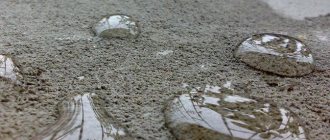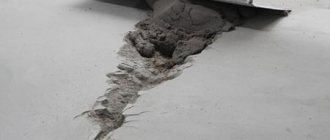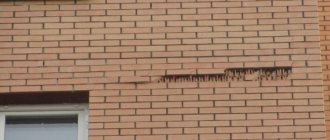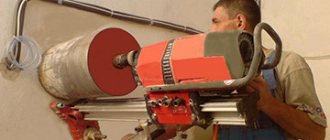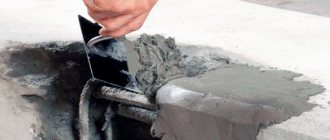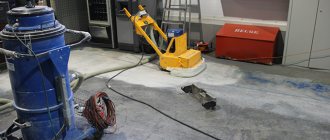What is used to “completely” seal cracks in concrete?
Epoxy resin and repair compounds based on it
A very effective and cost-effective way to seal cracks in horizontal dry surfaces: floors, screeds, blind areas, concrete platforms for various purposes.
Advantages of the method:
- Low cost and quick drying;
- Reliably fixes the seams and keeps them from further expansion;
The following materials and tools will be required:
- Angle grinder equipped with a diamond disc “for concrete” for crack preparation;
- Dust removal devices;
- Spatula and containers for preparing the composition;
- Primer “for concrete”;
- Epoxy resin with hardener;
- Fine purified sand.
The sealing technology consists of preliminary “spreading” of the crack, removing the loose layer of concrete and removing dust. In this case, the size of the defect should increase by more than 5 mm in width. You should also cut transverse grooves in the concrete for power screeds in a format of length 100-150 mm, pitch 400 mm. Operations are performed with an angle grinder and a vacuum cleaner.
The next stage is soil treatment and insertion of repair brackets into the transverse grooves. Next, according to the attached instructions, a repair solution is prepared: epoxy resin, hardener, fine sand. Considering that the setting time of epoxy resin is about 10 minutes, filling the seam, transverse grooves and leveling the outer surface should be carried out as quickly as possible.
Popular compositions for repairs: Epoxy resin ED-16, ED-20 (hardener purchased separately) Russia; Epoxy 520 resin, Spolchemie, Czech Republic; composition UZIN KR 416, Germany; Repair Technokolla, (Sika), Italy (the most popular composition for repairing concrete cracks).
Self-expanding cords and sealants
This is one of the most reliable, but quite expensive methods of concrete repair. Therefore, it is used mainly in swimming pool bowls, in underground parts of foundations and external surfaces of walls of buildings and structures.
Advantages of the method:
- The ability to select a material option for any defect;
- Complete tightness and durability;
- Possibility of installation in low ambient temperature conditions.
Required tools and materials:
- See the first two points of the previous method;
- Self-expanding repair: tape, cord or mat;
- Polyurethane sealant “for concrete”, mounting gun;
- Bench chisel, brush, paint brush, foam rubber.
The sealing technology is thorough, so before sealing cracks in concrete using a self-expanding material, carefully read the recommendations:
- Measurements are taken of the depth and width of the crack, based on the results of which an option for the type of self-expanding material is selected;
- The crack is widened and dusted using a grinder, chisel and vacuum cleaner;
- If the defect depth is up to 60 mm, you can use a self-expanding tape measuring 18x23 mm;
- Important! Self-expanding materials are not subject to caulking or other types of installation reinforcement;
- After installing the tape, cord or mat into the crack, the free space is filled with polyurethane sealant, and the protruding material is smoothed out with a spatula.
Use of sealants and self-expanding tapes
- Repair options
- Technology Methods of reconstruction work
Concrete coatings have long gained popularity among consumers due to their durability.
They are used not only for the manufacture of floors in production workshops or as road surfaces, but also in private housing construction.
This material will talk about how to seal cracks in concrete, which are often a coating problem.
DIY concrete floor repair
Their appearance is associated with:
- low tensile strength of the material, when when the structure dries, it contracts and shrinks;
- mechanical and chemical damage to the coating;
- temperature changes;
- corrosion of reinforcement.
Advice: it is necessary to repair any cracks as quickly as possible, regardless of the reasons for their appearance. This is one of the main tasks that can prevent further destruction of the structure.
Repair options
| Industrial method | |
| Injection | It is necessary to introduce polymer materials into cracks and voids, injecting them there using “injections”. This method makes it possible not to partially replace the concrete structure. It is often used when deciding how to repair cracks in a concrete wall. |
| Special repair composition for sealing cracks in concrete | In this case, the damaged surface is treated with a solution consisting of a cement-sand mixture and a polymer additive (furyl alcohol and sulfanol). After it dries, it is necessary to apply polyurethane sealant on top. |
| Shotcrete | Damaged areas are treated with the same material. An additional layer is applied to the surface, consisting of: water; cement; fractionated sand; organic additive (bitumen, resin, latex). Remember, this method increases the mass of the structure, thereby creating additional pressure on the foundation. |
At home they use:
- Cement liquid “dough” - for cracks whose dimensions do not exceed 3 mm.
- Compositions with epoxy resin.
- Special repair mixtures.
Tip: if the size of the cracks exceeds 3 mm, use a special mixture (Portland cement 1 part, water and sand - 3 parts each, as well as PVA glue).
There is also such a concept - self-healing of cracks, which implies their spontaneous filling. Typically, the method only works for very small defects no larger than 0.1 mm in size.
Cleaning the defect area
Technology
Below you will find instructions that will help you understand the entire cycle of work.
You should first prepare the tools and materials:
- hammer;
- chisel;
- cement;
- sand;
- PVA glue;
- water;
- brush;
- putty knife;
- mittens;
- paint brush;
- trowel;
- wooden slats;
- pieces of wire;
- metal smoother;
- sander.
Tip: if you forgot to leave technological channels in the foundation, floor or walls, diamond drilling of holes in concrete with crowns of the required diameter will help you.
Now you will learn how and with what to repair cracks in a concrete floor and not make mistakes when using the composition:
- Conduct preliminary preparations for the work site. To do this, check the crack itself and the area next to it so that there are no chips on it, which in the future may become shallow pits.
- Before repairing cracks in concrete, take a chisel and hammer and go along the entire length of the defect to open it up.
Joining the defect
Advice: if a hidden chip is detected, this piece of concrete should be removed.
- Clean the surface with water, a brush and detergent. You can use a vacuum cleaner to remove dust from the crack. Remove any remaining water with a sponge.
- Take a spatula and deepen the defect to about 5 mm, then the cement-lime mortar will be able to fill the entire space of the cracks and will hold firmly and for a long time.
The photo shows a cement-lime mixture for sealing cracks in concrete
- Prepare a solution by taking 3 parts sand, 1 part cement and add PVA glue to the mixture. Please note that the solution should not be thick or liquid.
- Take a trowel and pour the mixture into the crack, then moisten it with water.
Tip: if you are using a polymer composition, there is no need to moisten it with water.
If the cracks in the floor are of medium size and reinforcement is visible from them, they must be cleaned and treated with a solution that protects the metal from corrosion. You can also put pieces of wire of the same length and Ø4 mm into the grooves.
Using a trowel
- Apply the adhesive compound with a brush and spread it over all uneven areas. In this case, the layer thickness should be about 3 mm.
- Fill them with the solution without waiting for the composition to dry. Try to fill gradually, then the solution will lie more densely.
- Use a wooden lath to level the surface, removing the excess layer of mixture from it.
Tip: if the defect is very deep and large, apply the solution in several layers, wetting each with a small amount of water.
You can lay laminate flooring or paint a concrete surface literally within 24 hours, but you should not rush into gluing ceramic tiles.
Be sure to remember the following rule - the filling layer must be higher than the floor level, the solution will shrink after drying. Carry out subsequent work using a concrete grinder.
Tip: cutting reinforced concrete with diamond wheels will help you widen a large crack in the floor, after which the process is similar to working with medium-sized defects.
You can also seal a crack in a concrete floor using an elastic sealant, among the variety of which silicone is the most widely used. It is used to repair defects of various sizes.
How to Seal Cracks in Concrete Floors with Flexible Sealant
The process is no different from working with CIS. You will also need to clean out cracks or make additional grooves.
Tip: When applying sealant, it is necessary to moisten the surface.
Its main advantage is its drying speed, which is much faster than that of cement-lime mortar. But, the price of this method will also be higher.
We invite you to familiarize yourself with Concrete floors on wooden floors. Wooden floor on a concrete base: selection and installation
Today you learned the best and fastest way to repair cracks in concrete, and also that repairs must begin as soon as possible, otherwise further destruction of the surface area may occur. This will increase the cost of the process several times (see also the article “Pouring concrete in winter: disadvantages and advantages”).
This article proposed two main methods for dealing with defects in concrete floors and walls.
This article will help you find additional information on this topic.
Filling a crack in concrete with sealant.
The use of epoxy compounds is justified for filling cracks, but if you need to restore the coating on which a hole has appeared, and it is also affected by moisture, in this case it is better to consider elastic mixtures. Sealant is most suitable for this purpose. This composition has a significant drawback - its high price. However, there are a number of positive qualities:
- versatility: the sealant can be used to fill gaps of different sizes;
- compaction, sealing when sealing cracks in concrete, which allows the coating to come into contact with water without the risk of destruction;
- it is possible to apply sealant at temperatures below 0°C;
- ease of use;
- high speed of work completion.
This material is used in conjunction with a self-expanding tape or cord. Additionally, prepare a glue gun, chisel, and brush. The type of sealant and tape or cord is determined taking into account the parameters of the gap. For a leak 60 mm deep, use a 18x23 mm cord. Instructions for restoring the coating:
- The gap is widening.
- After removing the crumbling layer of concrete along the edges of the crack, they proceed to cleaning its internal surfaces.
- No primer treatment is required. Immediately lay the tape along the side walls of the embroidered gap.
- The remaining space is filled with a compound for sealing cracks in concrete. To do this, use a glue gun.
- If part of the solution protrudes above the surface of the concrete coating, it is leveled with a spatula and the excess is removed.
It’s worth saying right away that this method of sealing defects is very expensive, so it is most often used when repairing concrete bowls of country pools. However, despite its high cost, the use of sealant and self-expanding cords has its own advantages:
- the ability to process any type of defect;
- complete tightness;
- the ability to carry out installation work in cold weather conditions.
To work, in addition to the standard set of tools, you will need:
- mounting gun;
- self-expanding tape or cord;
- chisel and brushes;
- sealant for concrete.
However, before covering up the flaw, you need to measure the dimensions of the cracks and purchase the right type of sealant and tapes depending on this. For example, if the hole depth is 60 mm, then an 18 x 23 mm cord will do.
The next step is necessary:
- Expand the cracks and remove dust.
- Install the cord into the recess.
- Fill the remaining space with sealant.
- Smooth out the protruding compound using a spatula.
After completing the work, you won’t have to guess how to putty the surface or caulk it. It is enough just to apply the composition and smooth it out.
If we talk about the best compositions of this type, the most popular are:
- Domestic ELASTOSIL PU 20 costs 280 rubles per 600 ml.
- The composition is from the French manufacturer Rubberflex, which today sells for 300 rubles per 310 ml.
- PLOW tape made in Russia costs about 260 rubles per linear meter.
This method is suitable for repairing defects that occur on the surface of swimming pool bowls, for restoring external walls and monolithic foundations. Stages of repair work:
- Cutting a crack, removing weak elements and dust.
- Measuring the width and depth of the crack.
- Selecting a suitable self-expanding cord or tape.
- Laying the cord or tape into the prepared cavity.
- Fill the remaining space with polyurethane sealant using a mounting gun.
A significant advantage of this method is the ability to carry out work at subzero temperatures.
Additives to concrete for self-healing of possible cracks in concrete
Russian engineers have developed a concrete additive that promotes the formation of hydrophobic crystals. The additive “works” only in a poured structure in contact with moisture.
By adding an additive to the concrete used to fill the pool bowl or foundation, the developer insures himself against the appearance of small and medium-sized cracks, which later turn into large problems.
At the moment, ONLY one produces this unique additive in Russia (Penetron Admix).
Other methods for effectively sealing cracks in concrete structures
Effective sealing of cracks in highly loaded concrete structures is carried out by injecting synthetic resins with low viscosity into the defects.
To do this, diagonal holes are drilled along the defect at an angle towards the crack. Bushings are inserted into the resulting holes, through which the repair compound, resin, is injected using special equipment. This technology allows for high strength and durability.
The problem of repairing cracks in concrete at home is solved in the following way. A liquid cement paste is prepared, epoxy resin with a hardener and proprietary repair mixtures are added to it.
This composition can be used to eliminate cracks less than 4 mm wide. For defects larger than 4 mm, a proprietary composition is used, consisting of 1 part cement, 3 parts water, 3 parts sand and PVA glue.
Cement mortars
When deciding how to repair cracks in concrete, such materials are most often considered. They are affordable, easy to prepare, and durable, provided the solution mixing technology is followed. With their help, you can fill shrinkage leaks, which are characterized by a small width. It is important to properly prepare the base surface. This will ensure high adhesion of the cement mortar to concrete.
Repairing a crack
Regardless of what materials you plan to use to fill the gap, the preparatory stage is always the same. Thus, it is recommended to joint the deformed area. If it is filled with a mixture for sealing cracks in concrete without preparing the base, then as a result the mortar layer will be deformed. You need to follow the instructions:
- Check the edges of the crack for strength. If the concrete in these areas has crumbled, it is removed. The jointing is carried out along the entire length of the gap. Its width after removal of exfoliated concrete should be 5 mm or more. Work at this stage is carried out using a chisel and a hammer. You can use a spatula.
- The surface is cleaned of dirt.
- Remove dust using water. In addition, moistening the crack will improve the adhesion of materials when applying the solution.
- Remove excess liquid.
- A cement-sand mixture is being prepared. You will need sand (3 parts) and cement (1 part). To increase the strength of the solution, PVA glue is added.
- Fill the crack with the mixture. It is important that the solution covers the entire surface of the concrete in the recess.
- While the cement dries, it is periodically moistened with a small amount of water.
Filling the hole
To repair a large crack or hole in a concrete wall, follow the instructions:
- The resulting hole in the coating is cleaned of contaminants and the crumbling material is removed.
- An anti-corrosion compound is applied to the walls and bottom of the hole. This need is due to the fact that there is reinforcement inside, which will begin to oxidize upon contact with moisture.
- The wire is being laid (the diameter can be 4 mm or more). It is cut into pieces, the length of which must correspond to the diameter of the hole in the concrete.
- The surfaces are treated with a primer composition, which will ensure increased adhesion of materials. A layer thickness of at least 3 mm is considered sufficient.
- Filling of leaks is carried out immediately after treating the surfaces with a primer. Then the coupling will be the best. If the hole is shallow, it can be filled immediately. In cases where it is large enough, restoration of the coating is carried out layer by layer with breaks for treating the solution with water from a spray bottle.
- The surface is leveled. To do this, use a rail. Movements are performed from side to side.
- When the mixture has set a little, remove its excess.
- The surface must be covered with a plaster composition. This will provide additional protection. Deep holes are leveled with a grinding machine.
It must be taken into account that the cement mixture is subject to shrinkage during the drying process. This will lead to slight subsidence of the solution layer. To avoid such consequences, it is recommended to use a little more mixture when filling the crack. The described method is suitable only for cases where it is not necessary to ensure the tightness of the coating and there are no increased requirements for surfaces.
In addition, cement compositions cannot be considered as an effective measure providing long-term results. The coating will soon continue to deteriorate. This means that the cement composition should be used only as a temporary measure.
This type of repair can be considered the simplest and at the same time the weakest. This is a temporary partial filling of floor, wall and foundation cracks in both dry and wet areas.
This filling of cracks does not seal them, but protects them from contamination for a while and prevents their further opening for a short time.
Repairs begin according to SNiP rules with the preparation of the opening itself.
It should be checked for chips, as other cracks and openings may form in them in the future. Use a chisel to run along the entire length of the crack to make it wider.
We suggest you familiarize yourself with Installing a socket box in concrete
Next, clean the crack with water and a brush to remove various contaminants; you can also use a vacuum cleaner. Remaining water should be collected with a sponge.
Using a spatula, you should also deepen the crack to 5 mm so that the solution holds more firmly.
For repairs, make a solution of 3 parts sand and 1 part cement, to which you also need to add PVA glue. The solution should be thick enough.
Pour it into the crack with a trowel and moisten it on top. If you carry out repairs using a polymer mixture rather than using a concrete solution, you do not need to wet the composition.
In medium cracks, reinforcement is usually visible; it must be cleaned and coated with a special product that will prevent corrosion. Next, you need to make grooves and place 4 mm pieces of reinforcement in them.
Now we apply the adhesive composition evenly over the entire surface so that the layer thickness is about 3 mm, and without waiting for it to dry, you need to fill it all with the solution.
The solution must be compacted so that it gets into all the recesses and irregularities, and the surface must be leveled with a wooden strip, which must be moved along the surface of the solution to the right and left and towards you.
If the gap is very deep, it is advisable to lay the solution in several passes. At each stage, the surface should be sprayed with a little water.
A special metal trowel will help make the concrete surface perfectly smooth. When the solution has hardened, the excess must be removed with a spatula.
If you paint or cover the concrete surface with a laminate, then such work can be done within a day after the repair is made, but you should wait longer to lay the tiles.
If this does not happen, use a grinding machine to level the surface of the former crack to the desired level.
If you are dealing with a crack whose width and length are large enough, you can process it before repairing it with a circular saw with a diamond disk, after which the repair is carried out according to the scheme described above.
This method of sealing is most often used as a temporary solution, since sealing does not occur during such repairs.
The method is relevant for both dry and high-humidity rooms where good waterproofing is required.

